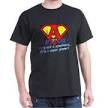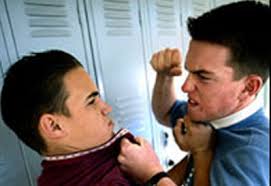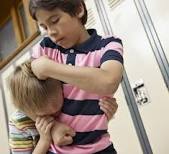Blog Archives
Funeral Footwork
Posted by JF
Now that things have settled down just a bit, perhaps I can get back to blogging.
My family and I traveled out of state to my father-in-law’s funeral during my last hiatus. I have posted before about the experience of attending a funeral from an aspie standpoint before, so I already knew I was in for a slightly uncomfortable time. However, I was also very aware that I was going to have a very important job at this funeral – my FIL’s death hit my wife pretty hard. She handled it surprisingly well, but she was still emotional. I was there to support her, because aspies are superheroes when it comes to lending support during emotional times.
Able to not understand what the big deal is in a single shrug.
There were times where I found myself standing around with nothing to do, so I started doing what I enjoy doing in these types of situations: I began to observe human behavior for interesting patterns. It didn’t take me too long to find one. I started noticing how people were standing and talking together. I noticed that when two people stood together, they almost never faced each other. They stood with their feet at an angle to the other person, like a conversation deflection of sorts – I’m not really interested in talking to you, but I don’t want to seem rude and ignore you, so I’ll meet you halfway. It was pretty consistent no matter the age or gender.
I decided that I needed to learn this move, post haste.
Even more interesting was how this dynamic applied when there were more than two people standing together. The “angled feet” behavior was still present, with each person angling themselves to avoid directly facing either of the other people. And as the group grew, the people adjusted their angles to fit the group’s size, often positioning themselves to form a social semicircle.
It was fascinating. Seriously. I felt like Pavlov, only my subjects weren’t drooling dogs.
And my beard wasn’t quite as bitchin’.
The most interesting thing happened when…
Wait a minute…
That’s totally Robert Duvall with a humongous beard!
Ok, where was I? Oh yeah…
The most interesting thing happened when two groups came together to form a large “supergroup” of sorts. Each group would open up slightly to accept the merging group, and after a moment or two of jostling, the people would fall perfectly into the angled feet position! The supergroup would often be a fairly large circle at this point, with nobody talking or looking directly at anyone else, yet they were all having a conversation with everyone at the same time.
Amazing!
From here, the supergroup would break up and the participants would float around the room until they joined up with others to form smaller group chains. And this dynamic happened over and over again. It was like watching so weird social cellular cosmos, with people aimlessly colliding with one another over and over again. It was cool to watch. It was even cooler not to join in. Instead, in between consoling hugs for my wife, I was able to let my mind wander onto other meaningless things. Such as….
See? Didn’t I tell you?
Posted in Aspergers, My Life, Social Anxiety, Uncategorized
Tags: antisocial, Aspergers, Aspie, awareness, behavior, conversation, death, emotions, family, friends, funeral, pavlov, robert duvall, small talk, social, Social Anxiety, uncomfortable
Autism and Bullying
Posted by JF
Bullying seems to be a hot topic nowadays. I’m not sure why all of a sudden EVERYBODY is all up in arms about this. It’s not like bullying is something new that kids just came up with this year, like listening to crap music like Lorde. Bullying has been around for quite a while. The first recorded use of the word “bully” occurred in 1530 (yes, I looked it up; I don’t spend all day making up fake facts for this blog, I’ll have you know), but the concept goes back way before that. There were even bullies in the Bible, for Christ’s sake.
Jesus likes!
Because of the nature of bullying behaviors, children on the autism spectrum at at a higher risk of being victims of bullying. Bullies often single out those who are weak or socially outcast and make an example of them. It’s not always about physical violence. The main motivation is an attempt by the bully to feel superior to others and to be looked at as being in a position of power. Due to the characteristics of autism (weak sensory perception, social awkwardness, etc.), children with autism or aspergers are juicy targets for the bully to get what he or she wants.
A parent of a child with special needs is then faced with a difficult situation. Very often, children with autism will have difficulty communitcating to the parents that they are being bullied. The emotions that come with being pushed around are hard to understand; the child may claim to feel sad, tired, or simply hide their feelings in order to avoid them. It is the parents’ job to keep an keen eye on the child’s temperment and watch for any changes that may indicate that something is wrong.
Or just outsource the job to the Chinese.
Bullies prey on fear; they count on their targets being to afraid to report them or do anything about it. Children with autism are already scared and anxious to begin with. A bully doesn’t even have to work hard to intimidate these kids; half the job is already done for them.
Another reason why it may be hard for parents to detect when their child is being bullied is that the child may not even realize that they are being mistreated. To children with social deficits, a bully may seem like a friend. After all, it’s someone who is talking to them and giving them attention. That’s a friend, right? Doesn’t matter if that the “friend” is taking their stuff, slugging them in the arm, and calling them names behind their back. That must be what friends do!
“Mom! Tommy and I are gonna go play ‘Get Beat Up By Tommy!’ “
Now, it’s clear that special needs children are especially vulnerable to bullying. However, all of you special needs parents shouldn’t jump up on your high horse and think your child will always and forever be free of blame when it comes to bullying. Remember all of that anxiety and fear I was talking about before? Well, a funny thing about those negative emotions – they tend to send you child’s self esteem crashing faster than Healthcare.gov.
Obama no likes.
These drops in self esteem can lead to children with special needs becomingthe bully. If the child has trouble understanding how to address social situations, the chance of inappropriate behaviors evolving into bullying is higher. We can’t just look at our children as wonderful little angels and allow ourselves to be blind to the other side of the coin. If you don’t want you child to be bullied, you have a responsibility to make sure your child doesn’t turn into one.
It’s clear that bullying is a critical subject that should be discussed with our children. We need to teach our children to be respectful of one another no matter what the situation. Remember, kids grow up to be people; the last thing you want to be responsible for is letting you kids turn into assholes when they are older.
Posted in Uncategorized
Tags: anger, antisocial, anxiety, Aspergers, Aspie, Autism, awkward, bully, bullying, emotions, fear, friends, parenting, self esteem, Social Anxiety, spectrum, stress
Aspie Halloween!!
Posted by JF
Halloween was probably my least favorite holiday as a kid. Don’t get me wrong, getting the tons and tons of candy was great. I was strung out on sugar just as much as the next kid when I was in grade school. The problem I had with Halloween was not the treats, but the tricks you had to pull and the hoops you had to jump through in order to get them.
Hoop 1 – Strength in numbers: Getting a group of kids together to wander through the neighboorhood wasn’t that big of a problem when I was very young, but it got more difficult as time went by and my aspie tendencies started to thin out my herd of friends. And trust me, nobody wants to see a kid trick-or-treating by himself. It’s lame, it’s sad, and all the kid ends up with is pity candy.
Doesn’t really work when you’re 8 years old.
Hoop 2 – Diversifying your palette: The Mount Rushmore of Halloween Candy is as follows: Tootsie Rolls, Twizzlers, Snickers, and Reese’s Peanut Butter Cups. These are the candies you fight your brother for or steal right out of your sister’s hand. But Halloween isn’t as simple as gorging on chocolate, peanut butter, nougat, and plastic strawberry goodness until you pass out from sugar overload. There are some seriously disgusting candies out there, and eventually you have no choice but to choke them suckers down.
What did we ever do as a human race to deserve those pink and white pieces of poison?
Hoop 3 – Privacy Invasion: Only on Halloween is it acceptable to ring someone’s doorbell at odd hours of the night unnanounced and demand something from the resident and offer absolutely nothing in return. Is this strange to nobody else but me? If I knocked on your door on August 18th and asked for a bag of Doritos, you’d think I was completely insane. Yet on October 31st, this behavior is not only normal, but it is encouraged. Needless to say, I was extremely uncomfortable as a child, intruding on someone’s life and confronting them in that situation.
“He’s back again, Mary! Hide the Cool Ranch!”
Halloween hasn’t gotten any better for me as an adult, either. Now I feel like a complete asshole, sending my kids up to some stranger’s door to get candy. They look down their driveways at me, and I can tell they think that all I want to do is hog my kids’ stash and eat the whole thing for myself. Just because they happen to be correct doesn’t give them the right to prejudge me.
It’s even worse when I stay home. Every year I tell myself I’m going to handle the trick-or-treaters with smoothness and grace. And every year I end up running around the house, cowering in fear, hiding from the windows when the doorbell rings. It’s pure torture.
If I can just go to Wal-Mart and buy a bag of candy and eat the whole thing myself, why can’t everyone else just do the same thing?
Posted in Uncategorized
Tags: alone, antisocial, anxiety, Aspergers, candy, friends, halloween, holiday, reese's, snickers, Social Anxiety, tootise roll, trick or treat, twizzlers
Can’t We All Just Get Along?
Posted by JF
Making friends is a lot harder than they led us to believe. It should be pretty easy – just find someone that you have something in common with, and figure out a way to bond over that subject. But what happens when the very thing you have in common with some people that you meet is the thing that makes it difficult to form friendship bonds with them?
My wife had a homeschooling friend come over to the house the other day, and this woman has two boys with Aspergers who are very close in age to my Aspie daughter. “They will get along great,” everyone said. Although it wasn’t a disaster, the kids didn’t mesh well together. The boys were actually more interested in spending time with my son who is a couple of years younger. My daughter, in her typical aspie way, takes this as a personal insult. She doesn’t take into account that:
a) children on the spectrum are usually drawn to children who are either slightly younger or slightly older, and
b) they are dudes who want to do dude things.
Dude things – the most efficient way to make mom completely lose her shit.
You can’t really fault the moms in this situation. People who like to read make friends in book clubs. Kids who play the same sport get along really well. Children on the spectrum should understand each other enough to bond with each other, right?
Right?
Judges?
In reality, having autism in common provides absolutely ZERO opportunities to bond over. In some cases, it may even hinder the friend-making process. Consider this situation – two spectrum children with OCD-like tendencies are attempting to build a tower out of blocks with each other. One wants to build a round tower, while the other wants to build a square house. Are these kids going to bond over their intense desire to have things exactly the way they want it, without compromise? Yeah, I didn’t think so. It’s like the one thing that the children have in common is also the thing that makes them completely different from one another.
Aspergers not only gives aspies a shaky common ground, the nature of Aspergers itself drives us away from making bonds. It’s simply easier to isolate. I remember once looking for an online Aspergers discussion board, but I couldn’t find a decent one anywhere on the internet. I chalk part of that up to my Aspergers itself, and that I couldn’t find one that I wasn’t comfortable with because none of them were “perfect.” But I believe another reason is that there aren’t a whole lot of discussion boards out there; we’re just not that into reaching out. To show just how bad the situation is, I did a little web search and found five Aspergers message boards. Then I found fifteen message boards for irritable bowel syndrome. It’s apparently three times as easy to find a friend if you periodically shit your pants that if you have Aspergers.
As you can clearly see, illustrated above.
One of the few places I’ve been able to form “friendships” with other Aspies is on Twitter. But in all honesty, how deep of a friendship can one develop at only 140 characters at a time? Then again, that could be exactly why I enjoy Twitter so much – I can build my friendships on my own terms, at my own pace. No rush, no pressure. Bite-sized bonding, if you will. It’s tailor made for us Aspies.
Posted in Uncategorized
Tags: alone, antisocial, ASD, Aspergers, Aspie, blogger, bonding, friends, friendship, internet, message board, OCD, playdate, Social Anxiety, spectrum, twitter, uncomfortable
This Is My Aspergers
Posted by JF
I have written in previous posts a little bit about the history of my Aspergers and what it was like for me growing up, but I haven’t really gotten into it in great detail yet. Every aspie is different, comes from a different background, and has a different story to tell.
This is my Aspergers. There are many like it, but this one is mine.
I only became aware of my Asperger-ish tendencies a few years ago when my daughter was diagnosed, but the roots go back to when I was very young. When I was in preschool, I remember bouncing back and forth between friends, trying my best to connect with whoever was within proximity of me at the moment. I tried my best to mimic in order to be accepted; this works pretty well as a child, however I can remember not really having a sense of who I was. I would absorb the traits of those around me in order to blend in.
The defining moment in my young childhood came at age 6 when I was hospitalized for a severe kidney condition. I got sick on the first day of school, was rushed to the hospital, and nearly died. I was in the hospital for 6 weeks, subjected to blood draws and regular dialysis treatments. My family was devastated that I was so sick and scared of losing me.
The thing I remember most vividly is all the cool toys I had in my hospital room.
Coming up next on Pimp My Pediatric ICU…
Granted, I was only six, so my memory of the experience shouldn’t really be picture perfect. But don’t you think it’s a little strange that I have absolutely NO memory of the horrible medical procedures that my mother tells me I had to endure, yet I can remember with great clarity the Lego kits my dad and I worked on and the inflatable Superman doll that hung in the corner during my entire stay? I think my brain decided that it wasn’t going to connect itself to what was going on, and I must have checked out and gone somewhere else mentally during the rough parts. I still use this skill to my advantage from time to time. I don’t know if the stress caused my brain to adopt an overall emotional disconnectedness – virtually “causing” my Aspergers – or if it was my aspie brain that allowed me to get through it. All I know is that the experience had a profound effect on me and my mental processes. It’s like my super hero origin story.
Able to create soul-crushing social awkwardness in a single sentence!
As I got older, I began to show more of what I realize now were classic autism/Aspergers traits. I memorized the bus route home from school, including street names; I even helped a substitute bus driver find the correct route on one occasion. I had a very rigid tv routine, watching my favorite cartoons every single day; I knew by heart when each was on and in which order. I would spend hours “racing” my Hotwheels cars, which actually meant lining up 30-40 of them one behind the other and moving them one at a time for a few seconds each. I would throw tantrums if I didn’t win while playing board games with my sisters. I would play ball in the living room by using a mini-bat to hit a foam ball aroud the house, completely oblvious to the risk of breaking things. I often played 2-player sports games by myself, switching between controllers to play both teams; I even kept stats and charted out seasons that I scheduled myself, long before games like Madden featured their own season modes.
The list goes on…
I actually hid the social aspects of my Aspergers pretty well during school. With the benefit of hindsight, however, the cracks begin to show. Bullies were constantly trying to get to me, only I was so socially clueless that I didn’t even notice. Eventually, thye pretty much gave up and moved on. One of my best friends (even to this day) was with a group of kids who would brutally make fun of me on the bus. One day the other kids weren’t there, so he invited me to his house to hang out. Oblivious Aspie Me said, “Sure!” I continued with my “blending in” strategy, getting along with many types of people but never really connecting to any of them. I had a small group of close friends, but even they were distanced from me; I very rarely hung out with any of them one-on-one.
“Thank God you guys are all here! I’m terrified of each of you individually!”
When I went to college, my isolation became official – I’m not exaggerating when I say I did not make one new friend during my four years in college. I tried a few times early on, but I just couldn’t make it work. In my mind, I had nothing in common with anybody at all. I had already figured myself as an outcast. Most of my social interaction came via the internet – where I could be whatever I wanted to be, take my time to measure my responses, and avoid the intensity of face-to-face contact. I actually met my wife over the internet during this time, and somehow she wasn’t completely turned off by my behavior when we met for the first time.
It was slightly less awkward than this was.
At the time, it wasn’t so obvious to my parents that something was up with their son. Autism spectrum disorders weren’t featured as prominently in the news as they are nowadays. But looking back now, and with the benefit of the knowledge I gained while working to get my daughter diagnosed… it’s pretty clear. My childhood is no doubt different from the stories of other spectrum children, but I’m sure it also runs parallel to them in many ways. I worry about my daughter a lot – will she have friends? Will she be happ? Will she be successful? Looking back on my story gives me a sense of peace. If I made it this far in the face of this challenge, then the potential of my daughter is limitless.
Posted in Uncategorized
Tags: alone, antisocial, anxiety, Aspergers, Aspie, Autism, awareness, bullies, bully, children, daughter, diagnosis, family, fear, friends, happiness, history, internet, isolation, parenting, self awareness, Social Anxiety, son, stress, tantrum, uncomfortable, video games, wife
























